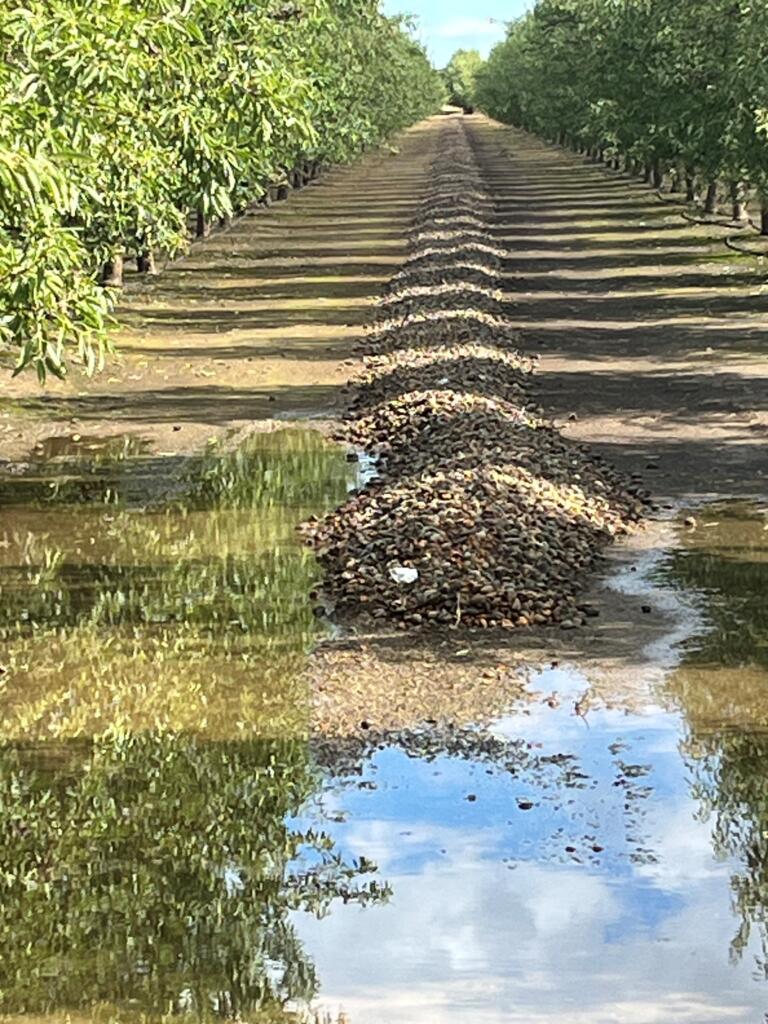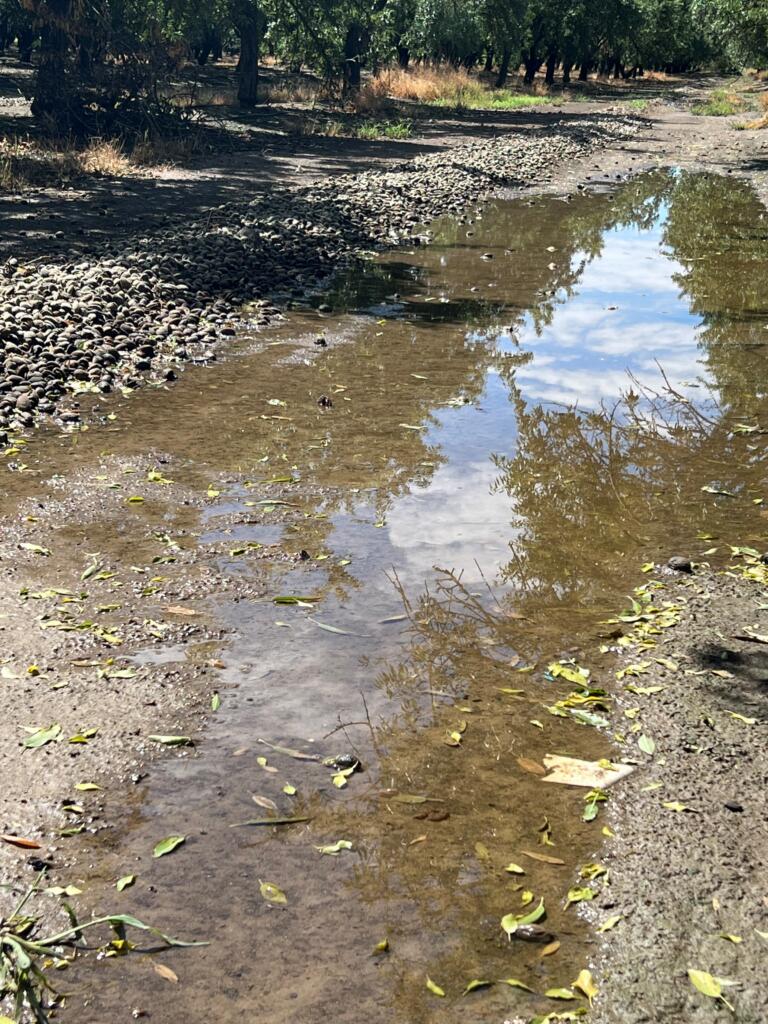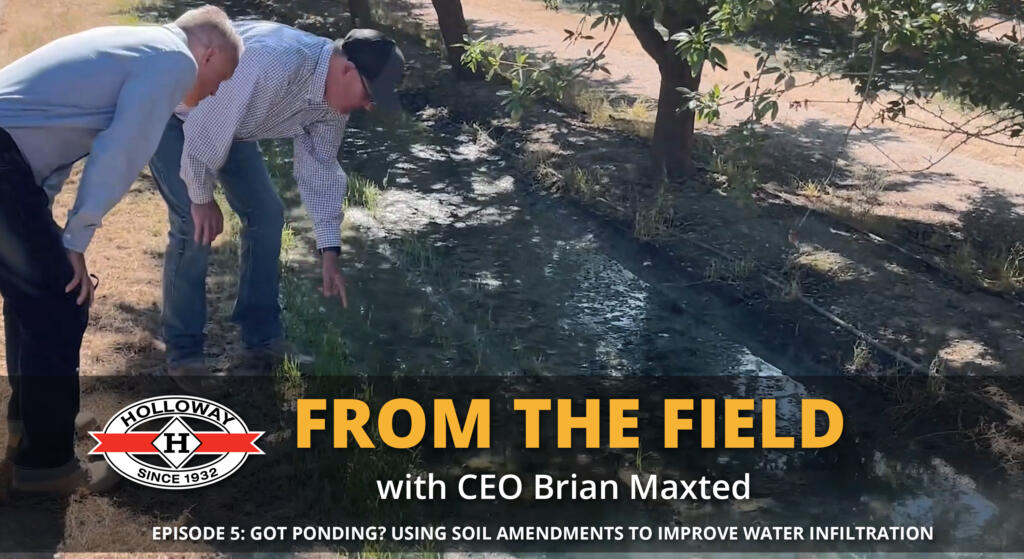‘It’s Gut Wrenching’: Standing Water Continues to Plague Farming Operations During Harvest Season
 Parts of the Central Valley were hit by as much as 4 inches of rain over the past week as Tropical Storm Hilary disrupted harvest season across California.
Parts of the Central Valley were hit by as much as 4 inches of rain over the past week as Tropical Storm Hilary disrupted harvest season across California.
While a little bit of moisture is usually welcomed in the Central Valley, a second August storm in as many weeks was troublesome for almond growers in the middle of harvest season, especially those who have nuts on the ground after shaking last week.
“Valley agriculture can take small amounts of rain this time of year,” Ryan Jacobsen, CEO, Fresno County Farm Bureau CEO Ryan Jacobsen told Western FarmPress. “This is different.”
Holloway’s agronomy team saw major issues Monday while making its rounds in Kern County, noting standing water on a number of high-producing orchards that already had nuts drying in windrows.
Holloway Director of Agronomy Steve Lenander said the most saturated orchard soils (pictured) could have clearly benefited this season from a gypsum application, which aids in water penetration and increased water-holding capacity.
“It’s a very unfortunate event in these cases, because they were very high yielding blocks, as you can see from the size of the windrows (3,500+ pounds/acre),” Lenander said. “That being said, the considerable amount of money that went into fertility is potentially lost now because of the decision not to spend a marginal amount on a ton of gypsum. We are talking perhaps several hundred dollars per acre in lost production. It’s gut wrenching.”
 According to UC Cooperative Extension Farm Advisor Franz Niederholzer, rain at harvest can “increase the risk of mold and concealed damage to nuts. Both of these conditions can reduce grower income.”
According to UC Cooperative Extension Farm Advisor Franz Niederholzer, rain at harvest can “increase the risk of mold and concealed damage to nuts. Both of these conditions can reduce grower income.”
Along with affecting quality/premiums, rain and muddy conditions from poor soil management can increase harvest costs if operations have to make additional passes through the orchard, or machine-dry almonds.
“We talk about the cost of inputs all the time, especially when it comes to fertilizer and pesticide applications,” Holloway CEO Brian Maxted said. “This year, due to market conditions, a lot of growers had to cut back on input and labor costs, and you can see the ramifications of that in the field.
“Soil amendments are a part of that equation. But the cost of inaction in terms of applying soil amendments and putting your soil health first, could be staggering. With all the moisture from last winter and these recent rains, we cannot stress enough the need to evaluate and treat the macro issues of compaction and penetration in your soil, before next winter’s rain.”
Maxted and Lenander discussed ponding issues earlier this year, following a rash of storms that slammed California to start the year. In Episode 5 of Holloway’s From The Field Series, the two revisited a customer orchard to see how soil amendments such as gypsum and compost helped improve ponding and water infiltration issues.
 “We forget that much of the San Joaquin Valley floor was native wetlands and swamplands before being cultivated for agriculture,” Maxted said. “In dry years, we worry about whatever precious water is available getting maximum use throughout the root zone, but in wet years, action through amendments is often more critical or else we risk literally drowning our orchards.”
“We forget that much of the San Joaquin Valley floor was native wetlands and swamplands before being cultivated for agriculture,” Maxted said. “In dry years, we worry about whatever precious water is available getting maximum use throughout the root zone, but in wet years, action through amendments is often more critical or else we risk literally drowning our orchards.”
The second August storm will continue to push back an already late harvest season.
And with lots of talk of an El Niño on the horizon, that window to get post-harvest soil amendments on could be another tight one this year.
“Now is the time to get into our orchards and get soil samples, so we can plan out post-harvest soil amendment applications,” Lenander said. “We can’t afford to have a repeat of last season with all of this rain, and the ponding and standing water that comes with it. We have to start making our soils a priority.”

From The Field, Ep. 5: Got Ponding? Using Soil Amendments to Improve Water Infiltration
Following up after the recent storms that slammed California the first two weeks of the year, Holloway CEO Brian Maxted and Director of Agronomy Steve Lenander revisit a customer almond orchard on Jan. 18 to see how soil amendments such as gypsum and compost helped improve ponding and water infiltration issues.
